As an SEO professional, you know that keywords form the foundation of any content strategy. However, with Google’s countless updates and other search engines following suit in hopes of catching up, everyone is on their toes in the race to retain relevance on SERPs.
Some SEOs find it exhilarating, some dread it, while others just want to rank higher.
This article will cover the latest keyword research trends, their significance, and, most importantly, their overall impact on your SEO strategy.
Top 10 Keyword Research Trends You Need to Know
1. The Evolution of Voice Search
Let’s start with this interesting insight from Sudhir Khatwani, Founder of The Money Mongers.
“You know, keyword research these days feels a lot like trying to catch the latest trend on TikTok. Everyone’s talking to their gadgets like old pals – Alexa, Siri, you name it. So searches are sounding more like coffee chats than stiff commands.”
With more than 1 billion voice searches occurring every month and 50% of American adults reporting that they use voice search daily for simple search queries, users will increasingly turn to voice search for quick answers, information, and assistance.
The natural language processing abilities of voice-activated devices and virtual assistants like Siri, Google Assistant, and Alexa have also evolved significantly, fostering these search types.
There’s no doubt that voice search has changed how we use technology. With smartphones and smart speakers, we can ask questions out loud. Technology now understands us better; we can even shop and order things just by talking.
The impact on keyword research is significant. For starters, voice search queries differ significantly from text-based searches. Instead of typing keywords, users tend to ask complete questions or use conversational language. As an SEO expert, you must adapt your keyword strategy to accommodate this shift.
The Impact of Voice Search on Keyword Research
- Long-tail keywords: we live in an age where 55% of millennials use voice search daily. When these users query these platforms, they use long-tail keyword phrases such as questions. Voice search often involves long-tail keywords and natural language phrases. Optimize for these conversational queries to align with user intent.
- Question-based content: create content that answers specific questions. Consider a topic’s who, what, where, when, why, and how.
- Local SEO optimization: a significant portion of voice searches are location-based. Ensure your content is optimized for local queries, especially if you have a physical presence.
- Featured snippets: voice assistants frequently source answers from featured snippets. Structured content and clear answers increase your chances of being the chosen source.
How to Adapt to Voice Search
Scott Lieberman, Founder of www.touchdownMoney.co, gives us a perfect answer.
“Businesses should develop written content conversationally to adapt to the growing number of searches performed using voice. When you type, you may notice you are succinct or let Google autocomplete your question.
But when we search with our voices, many of us tend to ask a complete question such as, ‘Which Chinese restaurants deliver near me?’ So, as a business, you’ll want to get these conversational phrases that people ask with voice into your content.”
2. Rise of AI Search
AI-powered search tools like ChatGPT, Gemini, Perplexity, and many others, are gaining a lot of traction.
Around 15 million US adults use them as their primary search tools and a whopping 71.5% have tried them. While traditional search engines still dominate, AI search is projected to reach 14% market share by 2028.
This shift is transforming how users discover content online. As AI search grows, websites will need visibility not just in Google Organic and other traditional search results, but also in LLM responses to maximize their online presence.
To track your website’s visibility in AI platforms, you can use Google Analytics and look at your referral traffic coming from AI platforms.
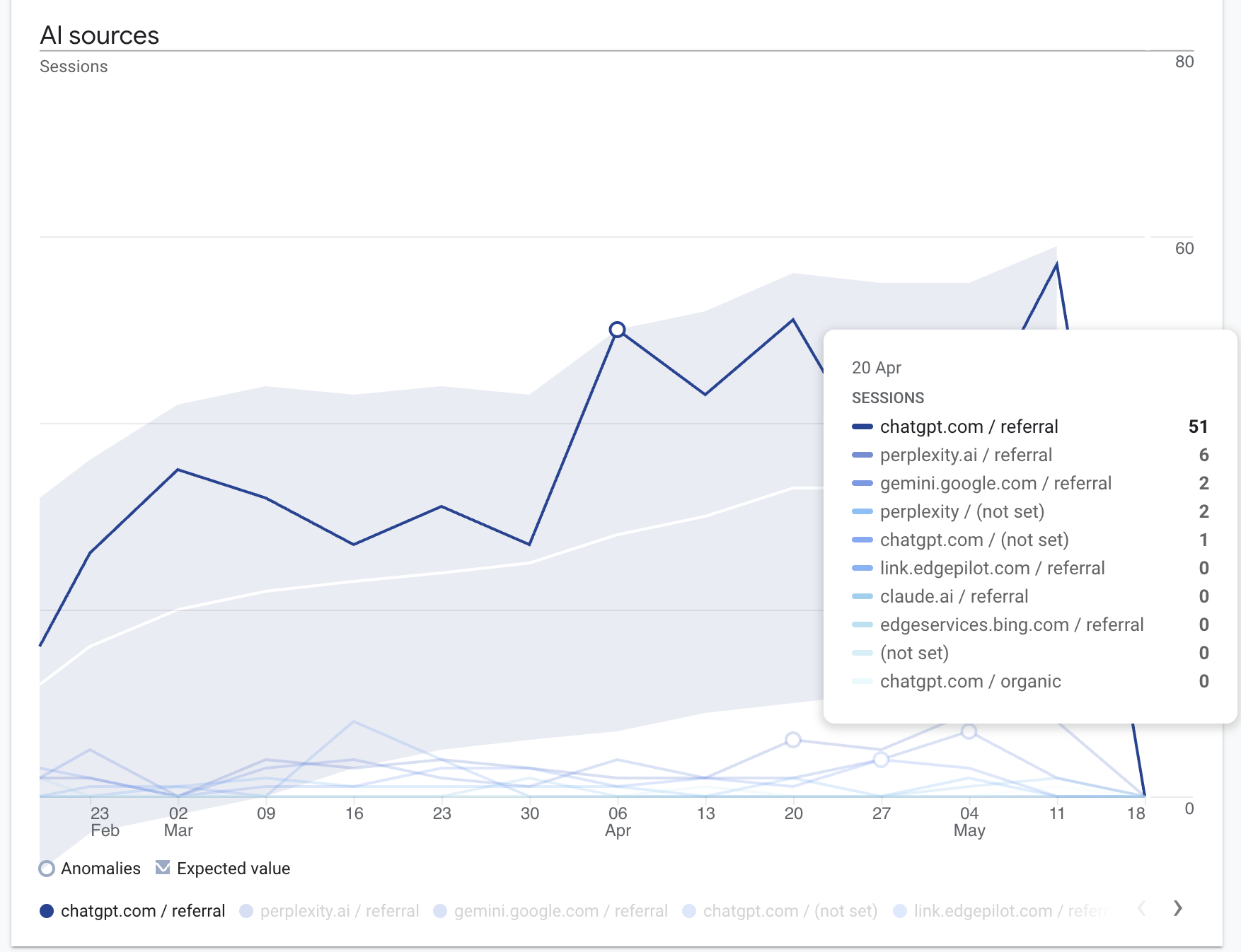
For a more granular view of your AI search visibility, dedicated AI rank trackers are emerging that monitor how often your content appears in AI responses for specific queries, providing insights similar to traditional SERP tracking but tailored for large language model results.
3. Increased Use of Long-Tail Keywords
Long-tail keywords are more specific, less competitive, and likely to yield conversions.
Over 70% of all search queries are for long-tail terms. On top of that, 56% of buyers search for queries that are three or more words long, while only 7% use one word or an acronym.
Using long-tail keywords has become the order of the day in daily searches. More so, site owners have tilted their gear in its direction not for popularity’s sake but due to its accrued benefits.
Research data released in May 2023 showed keywords with 10 to 15 words long received 2.62 times more clicks than one-word keywords. Overall, long-tail keywords get 1.76 times more click-throughs than really short keywords on Google’s organic search results page.
The Impact of Long-Tail Keywords on Keyword Research
- Capturing user intent: long-tail keywords provide a clearer picture of what the user is searching for. They reflect the specifics of the user’s query and intent, enabling your content to match their needs precisely.
- Reducing competition: long-tail keywords are often less competitive than broad, generic terms. This means that by optimizing for long-tail keywords, you can target a specific audience segment without battling against significant players.
- Enhancing relevance: content optimized for long-tail keywords tends to be more relevant and helpful. It addresses niche topics and specific questions, making it more valuable to users.
- Higher conversion rates: users searching with long-tail keywords are often closer to making a decision. As a result, content optimized for these keywords tends to have higher conversion rates.
4. The Mobile-Friendliness Update
Google rolled out its Mobile-Friendly update on April 21st, 2015, which revamped the phase of Search.
This update brought the wave of mobile keyword research, which focuses on search queries people use on mobile devices.
Most mobile keywords are short. You know it can be tedious typing on mobile devices, especially smartphones. That’s why most of these keywords are short-tail or medium-tail.
Also, mobile keywords are location-based. Keywords with the modifiers “near me” and “nearby” are the most used mobile keywords. People go with their smartphones everywhere and use them to find items, especially local products/services near them.
5. AI-Powered Keyword Research
We’ve seen AI impact search engines with updates like RankBrain. It’s only natural that they revolutionize keyword research as well. That’s why SEO experts maximize its power for effective keyword research.
AI can process and analyze vast datasets at incredible speeds. This enables you to gather insights from large volumes of keyword data, helping you identify trends, patterns, and opportunities that can be overlooked.
Also, AI algorithms are more accurate at predicting user intent. They can decipher and categorize the meaning behind search queries, allowing you to generate keywords primarily focused on what users seek.
You can also use this software to perform comprehensive keyword gap analysis, identifying keywords you aren’t targeting compared to competitors. Most importantly, you can analyze the content of your competitors to identify keywords driving traffic to their websites.
AI keyword research tools also understand the semantic relationships between words, helping you discover related keywords and synonyms that can be integrated naturally into your content.
6. Search Intent Over Search Volume

In the past, keyword research mainly revolved around identifying high-volume keywords and creating content targeting those specific terms. However, this approach often neglected the actual needs and desires of users.
Thankfully, with algorithm updates like BERT, Hummingbird, and RankBrain, the emphasis on search intent is much more paramount.
Ultimately, the overall goal is to effectively align your content with what users want to achieve with their search. In this age, content writing requires taking a step backward and understanding the underlying motive of each query, then creatively building a wall of text that provides the most relevant and valuable answers.
You can read our blog post on search intent for a detailed breakdown of how people search.
7. Proper Understanding of Keywords Via Entity SEO
Consider this sentence: The girl with the Apple phone has an apple in her bag.
Imagine you have a sentence like that on your page, and one of your target keywords is apple. You should know that the two apples mentioned in the sentence meant different things. One is a brand name, while the other is a fruit.
How will Google understand?
That’s where the concept of entities comes in!
We defined entities in one of our blog posts as an object or concept that targets a user’s search query. It could be a person, place, thing, or any other idea a user searches for information about. It can be physical objects, like a car, or abstract concepts, like a musical genre.
The introduction of entity SEO has provided room for more accuracy in understanding the context of a keyword.
Read our blog post to learn how to use entity SEO to improve your ranking and keyword research.
8. Increased Use of Branded Keywords
ASOMObile researched the top ten keywords in big countries like the USA, Mexico, Russia, India, Brazil, and Germany and discovered that an average of 80% of them were branded search queries.
In their words, “The big difference between 2021 and 2022 is that generic keywords in 2022 are almost gone. Same thing with 2023; almost every keyword right now is a branded term.”
Branded keywords are the specific terms or phrases that include a company’s brand name. For example, “Apple iPhone,” “Nike Sneakers,” “Keyword.com free trial,” and more. They typically target an audience specifically interested in that brand or its products.
If your business already has an established online presence, whether on social platforms or in the physical world, branded keywords help you connect with your existing loyal audience, ensuring they easily find and engage with your brand.
In addition, branded keywords typically have a high click-through rate (CTR) because users recognize the brand and trust its content. The average click-through rate for branded keywords in the number one position on SERPs is 43.26%.
Most importantly, by optimizing for branded keywords, you can control the narrative around your brand. This is especially important in reputation management, where you want to ensure that accurate and positive information appears when users search for your brand.
How to Optimize Your Content for Branded Keywords
- Optimize for brand name: ensure your website is well-optimized for your brand’s name. This includes having the brand name in title tags, meta descriptions, headers, and content. It helps search engines recognize your brand as a primary source of information.
- Leverage brand-related SERP features: use Search Engine Results Page (SERP) features like knowledge panels, site links, and featured snippets to enhance your brand’s visibility in search results.
- Online reputation management: actively manage your brand’s online reputation by addressing customer reviews and concerns. Encourage satisfied customers to leave positive reviews and respond professionally to negative feedback.
- Paid advertising: consider using pay-per-click (PPC) advertising to target branded keywords. This can help you secure the top positions in search results and drive more traffic from users actively searching for your brand.
9. The Power of Keyword Clustering Over Single Keyword Optimization
With Google’s focus on search intent satisfaction, relying solely on a single keyword to build real estate on the search results is no longer enough. You need a strategic keyword approach prioritizing context and search intent over stuffing content with a single search query.
That’s why keyword clustering has recently been an anchor strategy for SEO experts.
Keyword clustering is an SEO strategy that involves grouping similar keywords or search terms based on semantic relevance and topic similarity.
Search engines now employ semantic search, meaning they understand the meanings of words and the relationships between different terms. Keyword clustering capitalizes on this by organizing keywords based on their semantic connections.
A single piece of content optimized for a keyword cluster has the potential to rank for multiple keywords within that cluster. This maximizes the reach of your content and increases organic traffic.
For example, “best coffee machines, “ “best home coffee machine,” “best coffee machine [year],” “best coffee machine with grinder,” “best automatic coffee machine,” and more are all different keywords but can be tentatively used by a searcher looking for the best coffee machine.
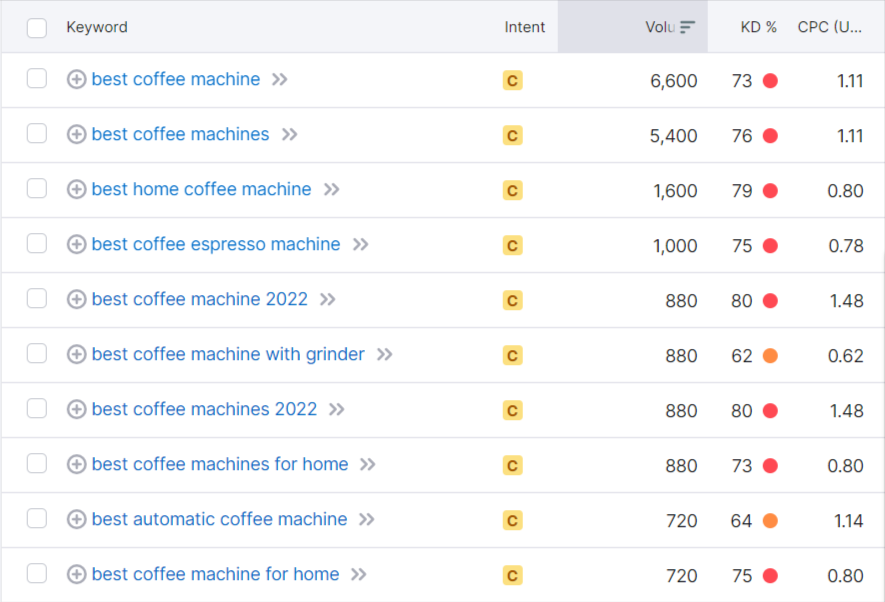
You can optimize these keywords in your content and rank, not just for one keyword but multiple keywords with the same user intent.
Many big sites in your industry implement this hack to establish their authority on their target keywords.
Further reading: Keyword Clustering: What It Is and How It Drives Higher Ranking in SERPs
10. Tracking Keyword Rankings
Keyword rank tracking is a continuous trend. Site owners use this strategy to monitor how they are faring on SERPs for the target keywords and, in general, measure the success of their SEO campaign.
This SEO practice started manually with SEO directors typing their keywords into search engines and scrolling through the endless search result pages to find their sites.
Keyword rank trackers like Keyword.com save time and produce a more accurate result. With Keyword.com, you can see your SERP history. You can see your competitors — who’s in which positions? And you can analyze what they are doing.
Here’s how it works:
- Sign up for a Keyword.com account. You can get started with a free trial.
- Create a new project and manually enter your keyword(s) or upload them.
- Stroll down the page to choose your keywords, device option, language, and location. Click Add Keywords after entering the data.
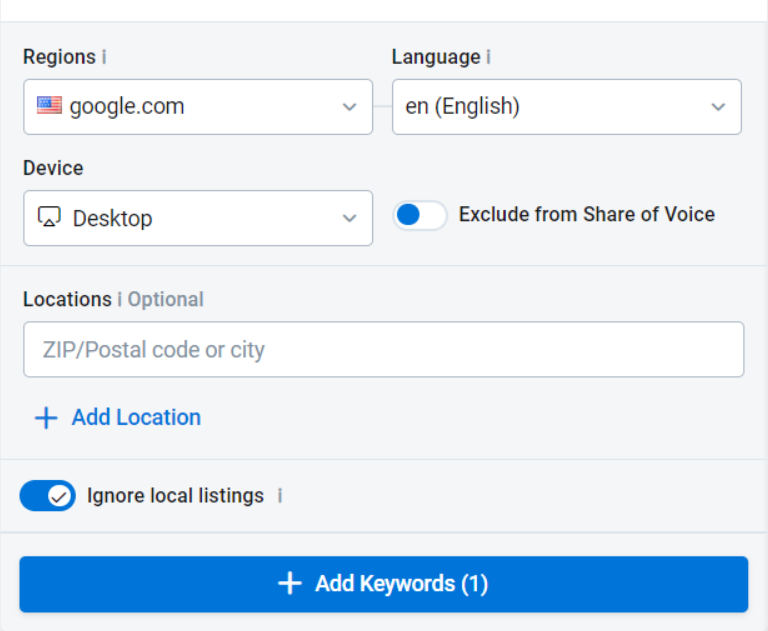
- The following page provides your keyword organic performance on SERPs like a mapped-out soldier plan. Every nitty-gritty about your keyword is displayed for effective corrections and strategy implementation.
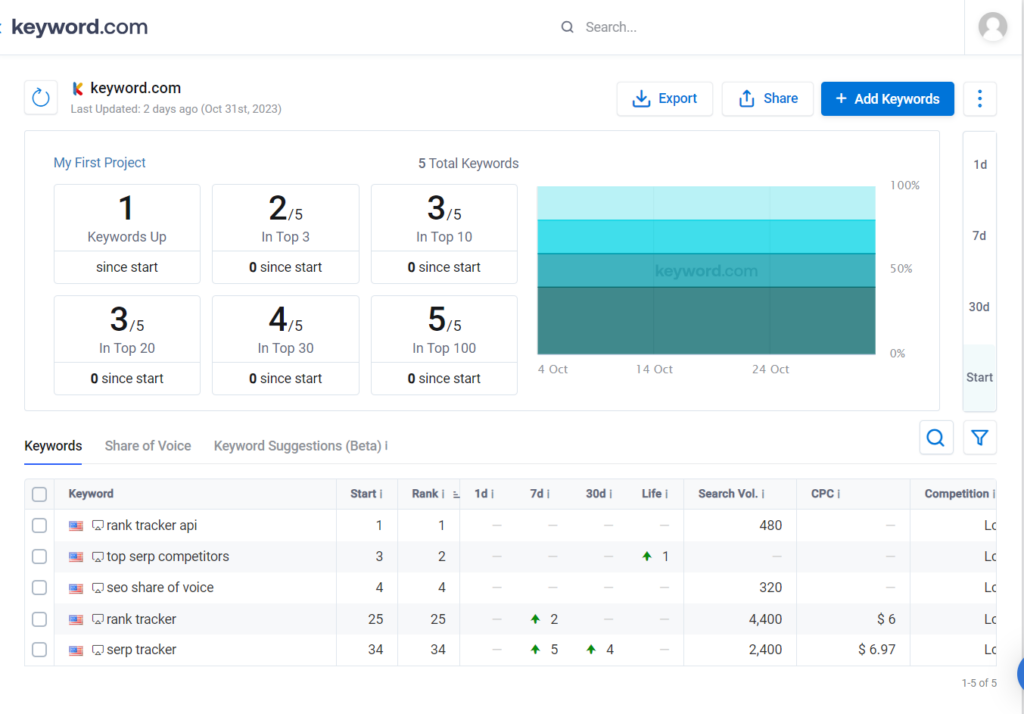
Firstly, you have the number of your uploaded keywords ranking in the top 3, 10, 20, 30, and 100. You can alter the result using the filter to compare rankings as far back as 30 days.
This keyword monitoring tool also has a Share of Voice feature that shows your ranking for a particular keyword compared to your top ten SERP competitors.
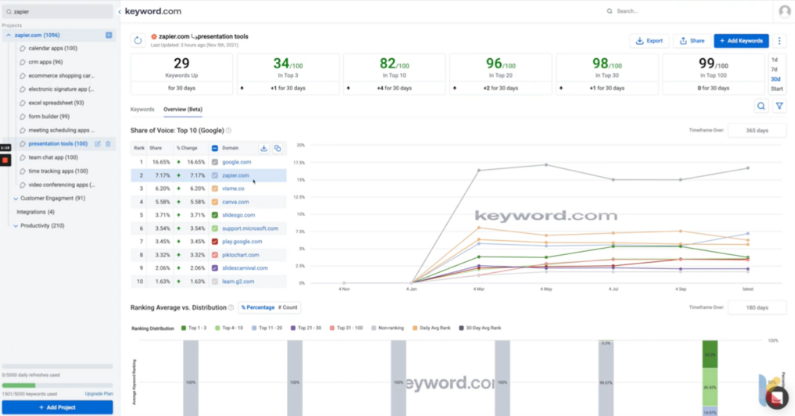
The time graph gives a pictorial view of your site’s ranking compared to its competitors over time. You can adjust the time frame and compare rankings as far back as 365 days.
Keyword.com provides daily updates to go with your early morning coffee. This feature allows you to identify quickly and outperform any ranking fluctuations. You can also add coworkers and clients to collaborate in your account or share reports directly with them via the one-click shareable link.
Try the consultant plan with a free trial to track 200 keywords daily with zero limits on the number of sites.